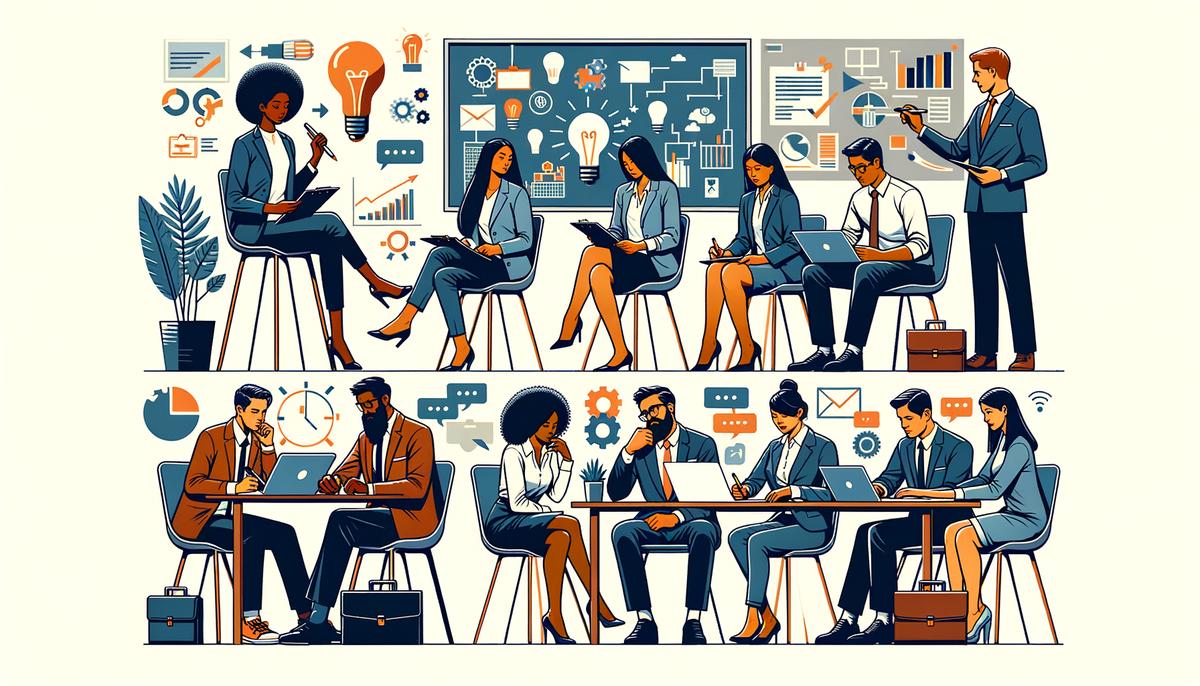Achieving a balance between creativity and business skills is essential for success in the creative industry. This balance allows individuals to create innovative work while ensuring its viability in the marketplace.
Defining Balance
Striking the right balance between creativity and business acumen involves recognizing the importance of both elements for a successful creative endeavor. Creativity drives innovation and sets products or services apart in a competitive market. Business acumen, on the other hand, ensures that creative ideas are feasible, financially sound, and effectively address market needs.
For creatives, developing a new product often begins with a spark of inspiration, where creativity pushes boundaries to create something original. However, an idea, no matter how innovative, needs a solid plan to become reality. This is where business skills such as market research, budgeting, and strategic planning become essential, testing the idea's real-world feasibility.
Fostering an environment that values open communication is crucial for merging creativity with business. This involves creating a space where creative minds feel free to propose ideas and business experts evaluate their viability. Both parties should respect and understand each other's contributions, working collaboratively rather than separately.
Intellectual property protection is another aspect where creativity and business intersect. Artists and creators must understand how to legally protect their work, which requires knowledge of copyright laws and patent filings. This protective measure ensures their creative outputs are not used without permission or proper compensation.
Sustainability and scalability of creative projects often depend on effective business management. Understanding how to scale a product without compromising its creative essence is crucial for long-term success. This might include considering various distribution channels, exploring multiple revenue streams, or adapting the product based on customer feedback, all while maintaining the original idea.
Learning from successful creative businesses can be insightful. Many have mastered the art of combining creativity with sound business strategies, often investing in both areas to support growth. They maintain a customer-centric approach, continuously innovating while ensuring their operations remain efficient and focused on long-term goals.
Allocating resources effectively between creative tasks and business operations is also crucial. Budget constraints may require prioritizing certain projects or stages of development, necessitating a clear understanding of what will bring the most value to the venture.
Resilience is key for balancing creativity with business. Creative endeavors are full of uncertainties; market preferences change, and what was innovative yesterday may become outdated today. Successful individuals learn from setbacks, seeing them as opportunities to refine their strategy or creative approach.
It's clear that neither creativity nor business can succeed alone in the pursuit of successful ventures. Each complements the other, creating a symbiotic relationship where one contributes to the success of the other. Successful creatives understand this balance and use it to drive their ventures from mere ideas to tangible, successful outcomes.

Creativity in Business
How Creativity Becomes a Business Superpower
Amid endless discussions on profit margins, market shares, and business jargon, creativity emerges as a compelling force that demands attention. Its role within the business context is an essential ingredient in the formula for modern enterprise success.
In a marketplace where consumers have numerous choices, creativity shapes identities, carves niches, and differentiates businesses not just on price or quality but on innovation and distinction. Let's explore how creativity powers the core of business excellence.
- Solving the Unsolved: Creativity is a powerful problem-solving tool. When businesses face operational or strategic challenges, creativity navigates through ambiguity, generating effective and sometimes revolutionary solutions. It challenges the status quo, asking "why" and "what if," guiding businesses toward unexplored territories that may hold the key to innovative solutions.
- The Genesis of Products: Every product starts as a spark of creativity. But creativity's true significance lies in reimagining existing products. Through creative thinking, companies discover new uses for their products, enhance features, or design products that combine various consumer needs into one efficient solution. Apple's first-generation iPhone wasn't just a phone; it was an idea that redefined what a phone could be — an example of creative product development.
- Standing Apart in a Sea of Sameness: In a world of similarities, how does one get noticed? Creativity is the guiding light that leads businesses through the dense fog of competition. By incorporating creative thinking into brand narratives, marketing strategies, and product design, companies can project uniqueness that attracts and retains consumer interest. It's about creating an identity that resonates emotionally with consumers, making your brand not just seen but remembered.
- Catalyst for Adaptation and Growth: The business landscape is dynamic and challenging. Creativity, applied within this context, enables businesses to adapt, pivot, and evolve. It fosters a culture of flexibility and resilience, empowering organizations to turn obstacles into opportunities. Creative diversification strategies or innovative growth tactics ensure businesses not only survive but thrive amid change.
- Humanizing Brands: In an era valuing digital connectivity, the desire for authentic human experience is strong. Through creativity, businesses craft stories, create experiences, and design interactions that go beyond mere transactions. It imbues brands with human qualities — empathy, humor, and warmth — transforming them from entities to partners in the consumers' life journey.
- Fueling Collaborative Innovation: Creativity acts as a unifier — bringing together diverse minds with varied expertise, each engaging in creative dialogue. This collective creativity sparks innovation, generating ideas that could potentially redefine industries. Google's 20% project time encouraged an environment where employees could pursue side projects, leading to innovations like Gmail and AdSense. It demonstrated how businesses could become innovation incubators through collective creative freedom.
As businesses navigate through the challenges of competition and change, embedding creativity at their core can be transformative. It's about integrating creativity into the corporate DNA, ensuring it permeates strategy, operations, and leadership.
Creativity is a facilitator of uniqueness, a catalyst for evolution, and a bridge to human connection — guiding businesses not just to survive but to achieve significant successes in the business realm.

Practicality and Protection
Why Practical Business Sense is Crucial for Creatives: Navigating the Realm of Tangible Success
Creatives, thriving in their worlds of imagination, often find themselves at a crossroads where their artistic path intersects with the realities of business. It's at this junction where practical business sense becomes an indispensable guide. Let's explore why its combination with creativity is essential for achieving success.
Legal Considerations: Protecting Intellectual Property
The world of copyrights, patents, and trademarks can be complex for the uninitiated. However, this legal landscape holds the keys to protecting creative work. Imagine creating a masterpiece, only for it to be used by someone else without permission. Practical business acumen steps in, ensuring that your creative endeavors are shielded from unauthorized use. Understanding intellectual property laws ensures that your work remains rightfully yours, guaranteeing both recognition and financial compensation for your creativity.
Financial Management: Turning Ideas into Sustainable Ventures
The notion that "true artists" must struggle financially is outdated and misleading. Financial management in the creative sphere is not merely about survival; it's about thriving. Mastering balance sheets, cash flows, and profit margins empowers creatives to transform their passion projects into sustainable ventures. Practical business sense in finance involves not just keeping the business afloat but strategically planning for growth, diversification, and long-term success.
Strategic Planning: Orchestrating Success
In the world of business, understanding strategy is understanding timing, rhythm, and composition. A solid business strategy for creatives considers the current market trends, anticipates future changes, and aligns the creative process with consumer demands. This strategic foresight requires practical knowledge, guiding creative passions to resonate deeply and lastingly with the audience.
Navigating the Market: Connecting with the Right Audience
Even the most brilliant innovations or creations risk obscurity without a clear path to their target market. Practical business sense serves as a guiding light. It involves understanding the evolving needs of consumers, identifying niche markets ripe for innovation, and employing effective marketing to connect your creative work with the right audience. Understanding market dynamics and developing adaptable strategies to stay relevant and visible requires strategic thinking.
Combining practical business sense with creative pursuits is not about compromising artistic integrity but about enabling it to reach new heights. Legal protection safeguards the essence of creativity; financial management ensures its sustainability and growth; strategic planning orchestrates its journey towards meaningful impact. Like a well-choreographed dance, where strength and grace intertwine to create captivating art, the blend of creativity with practical business skills orchestrates a performance destined for lasting success. This synergy allows creatives to dream boldly and sustainably in the tangible realms of shared reality.

Creative Solutions
The Canvas of Innovation: Creativity as a Trailblazer in Business Solutions
When Brian Chesky and Joe Gebbia were strapped for cash, they transformed their living room into a "bed and breakfast" for a design conference when all hotels were booked. This innovative idea revolutionized the hospitality industry. Airbnb leveraged technology to create a peer-to-peer network, empowering anyone with extra space to become their own innkeeper. It was creativity carving out a new market.
Once struggling in the early 2000s, Lego's tale of resurgence is one of reimagining through creativity. By integrating storylines through movie franchises, collaborative projects, and digital gaming interfaces, Lego transformed its product offerings. They built an ecosystem where physical and virtual constructions harmoniously exist, engaging both young minds and adults. This blending of tradition with technology—fueled by creating a diverse product ecosystem—revitalized Lego.
Tesla took on the task of making electric cars not just viable but desirable. Embodying creative thinking, Tesla diverged from the standard small, inconvenient electric vehicle stereotype by introducing the luxurious Roadster and Model S. Creativity didn't just drive design; it influenced their business model with direct sales and Supercharger networks. Tesla redefined the energy sector's boundaries through the creative integration of renewable energy solutions.
Kickstarter transformed the notion of funding projects on public faith and anticipation into a groundbreaking crowdfunding platform. By allowing creatives to pitch directly to potential backers, Kickstarter sidestepped traditional financing barriers, creating a symbiosis of trust and innovation. This model catalyzed thousands of projects and birthed a new realm of business financing.
These examples illustrate the transformative power of creativity in forging solutions, business models, and engaging customer relations. Creative thinking becomes a catalyst in the business domain – transforming challenges into opportunities. Each story demonstrates the potential for innovation drawn from the wellspring of creativity.
Creativity stands as the essence that breathes life into unique business solutions. It challenges entrepreneurs in the business arena to think outside the box, blend narratives with numbers, and pursue the opportunities where tomorrow's success stories await imaginative initiation.

Balancing Act
Navigating the Tightrope: Balancing Creativity with Business Imperatives
Your creative journey begins with a plan—a charting of goals that are both imaginative and achievable. Set your sights on goals that bridge creativity with practicality. Outline issues and timelines for that comic book series. Plan one innovative dish at a time for your avant-garde cuisine venture. Sub-goals—manageable, tangible milestones—pave your path to success. A modular strategy helps transform abstract dreams into concrete steps.
Allocate dedicated time for creative pursuits and separate time for business responsibilities—a partitioning of creative and operational tasks, where neither interferes with the other, preserving the focus and effectiveness of both. The Eisenhower Matrix is a useful tool to prioritize what requires immediate attention and what can wait. Within the structure of discipline lies freedom—the freedom to create unbounded and conduct business meticulously.
Financial planning—the development of budgets to fund creative pursuits and sustain operations—is essential. Leverage technology; many tools exist to streamline tasks, automate procedures, and free up time for creativity. The most invaluable resource is people—the synergy of collaborations that amplify output and ideas exponentially.1 Cultivate a network of creatives and business experts; in unity, there's strength—a force multiplier for aspirations.
Mindfulness practices—be it meditation, nature walks, or expressive dancing—are ways to recharge drained energy reserves. Acceptance becomes crucial—the acknowledgment that burnout is counter to productivity. By taking steps for self-care, one ensures the continuity of creativity interlaced with business acumen.
Manage expectations—a challenge for many creative endeavors. In the process of blending creativity with business, recognize success as a mosaic crafted piece by piece. Celebrate each small victory, learn from every setback, and adjust as needed based on realistic factors. Perfection is an elusive goal; chasing it often leads to frustration. Aim for progress—for improvement balanced with satisfaction and understanding.
The effort to balance fierce creativity with stringent business demands is challenging yet rewarding—a testament to one's command over their craft and their destiny. Through realistic goal-setting, effective time management, strategic resource deployment, energy conservation, and managed expectations, the creative's path becomes clearer—not as a trail filled with compromise but as one brimming with possibilities.























